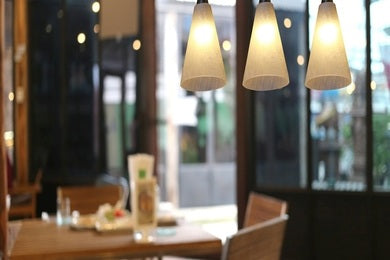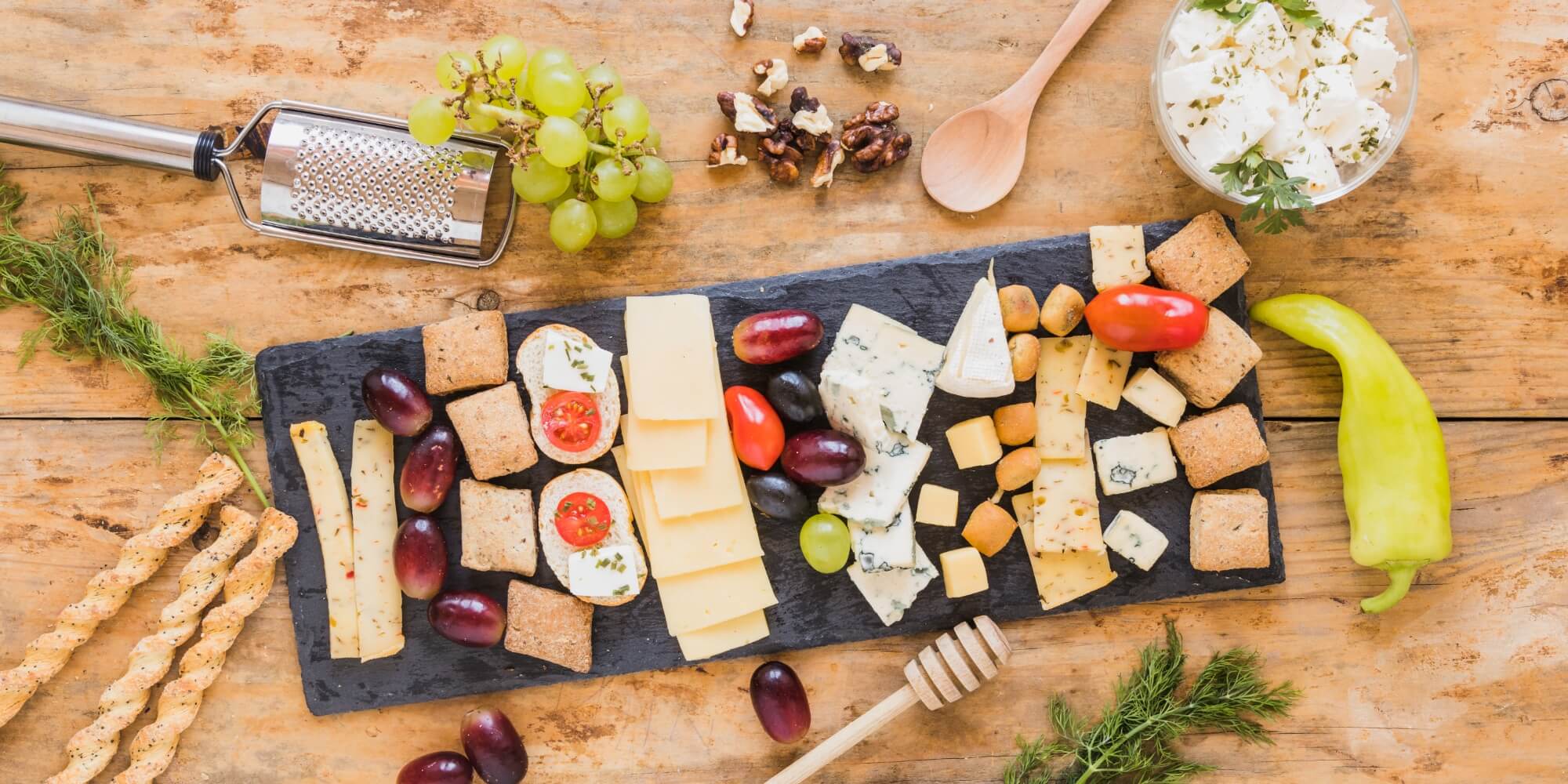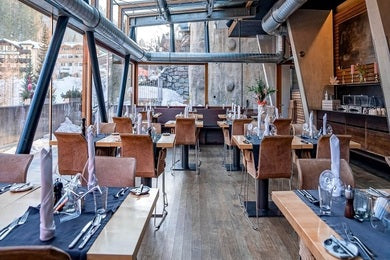
How to Mix and Match Types of Lighting
Lighting can define the atmosphere of a restaurant or café, setting the desired mood. It's all about balancing functionality with aesthetics to create an inviting setting. Thoughtfully combining different types of lighting helps highlight key areas like dining tables, counters, and lounge spaces. Every light source plays its role in shaping the ambiance and enhancing customer comfort. With the right mix, your dining space will feel warm and stylish.
Why Understanding Different Lighting Options Matters
Lighting determines the atmosphere of a restaurant space, directly influencing convenience and customer experience. Guests might not always notice the details, but the right lighting types influence their comfort and mood. The impact goes beyond decoration - it shapes the perception of your brand.
Carefully balancing different types of lighting ensures every corner serves its purpose. Task lighting improves functionality in key areas like service counters, while accent lights highlight design elements or artwork. Each layer works together to attract attention and enhance visual appeal without overwhelming the space.
Owners and designers have endless lighting options to consider when planning interiors. Warm tones often encourage relaxation and longer visits, while cooler tones keep spaces feeling fresh and modern. These choices must align with the restaurant's theme and target audience to create a seamless experience.
With so many types of lighting fixtures available, it's critical to match style with functionality. From industrial pendant lights over tables to elegant sconces on walls, lighting fixtures can be both practical and decorative. Thoughtful placement and selection tie the entire interior design together.

Key Lighting Categories: Ambient, Task, and Accent
Lighting is more than just a practical necessity - it's a powerful design tool. There are three main types of lighting: ambient, task, and accent lighting. Each serves a specific purpose, so your choice should depend on the details you want to highlight.
Ambient Lighting: The Foundation of Atmosphere
At its core, ambient lighting definition refers to the general illumination of a space. It provides a consistent base layer of light, ensuring that guests and staff can navigate comfortably. This option may involve using ceiling fixtures, recessed lights, or even large pendant lights that softly illuminate dining areas.
While ambient lighting sets the stage, it must also align with the restaurant's theme. For example, warm ambient lights create intimacy in fine dining spaces, while brighter tones keep a lively energy in casual cafés. This foundational layer also supports other lighting elements without overpowering them.
Task Lighting: Focused and Functional
The task lighting definition refers to lights that illuminate specific areas for functional purposes. In restaurants, task lighting ensures clarity in zones like service counters, kitchen stations, or even individual dining tables. These lights must be bright enough for their intended purpose without disrupting the overall ambiance.
Well-placed task lighting improves functionality and enhances the overall dining experience. Think of adjustable pendant lights over dining tables or under-counter lights in bar areas. These choices ensure clients can comfortably read menus or enjoy their meals without straining their eyes.
Accent Lighting: Adding Character and Style
In a broad sense, accent lighting definition refers to light used to highlight specific features or design elements. In cafes, it draws attention to artwork, architectural details, or standout decor pieces. Accent lighting can create focal points, guiding guests' eyes to areas the designer wants to emphasize.
There are countless accent lighting examples and use cases. Wall sconces framing a vintage mirror, spotlights illuminating a feature wall, or LED strips highlighting a bar counter - all these fall into this category. These touches add charm and sophistication, elevating the space's personality without overwhelming the overall design.

An Overview of Different Types of Lighting and Fixture Choices
Creating the perfect ambiance requires a thoughtful combination of carefully chosen fixtures and types of lighting. From soft overhead glows to strategically placed spotlights, each layer serves a particular purpose. Let's discuss the most popular types of lighting fixtures that contribute to both functionality and style.
Pendant Lights
Among the most versatile types of indoor lighting, pendant lights are a must-have for restaurant interior design. These fixtures provide focused light over dining tables, counters, or bar areas. Their flexibility makes them a decent choice for both casual and upscale dining spaces.
Pendant lights excel at balancing function and aesthetics. They illuminate specific areas without overwhelming the venue, making them perfect for creating cozy and intimate corners. Whether clustered together or spaced evenly above tables, they contribute to a cohesive lighting design.
Wall Sconces
Wall sconces offer unmatched practicality. Mounted directly on walls, they save valuable space while adding a sophisticated touch. Wall sconces create soft and accent lighting, enhancing architectural details or artwork.
These fixtures work particularly well in smaller dining areas or along hallways. They offer localized illumination without overpowering the overall lighting scheme. With their diverse designs, wall sconces can complement both modern and traditional restaurant aesthetics.
Recessed Lighting
One of the most practical types of indoor lighting is recessed illumination. These fixtures are installed directly into the ceiling, providing a clean and sleek look. They may highlight specific areas like service counters or artwork displays.
Recessed lighting is especially effective in spaces with lower ceilings, as it doesn't add visual clutter. When strategically placed, it offers even illumination across dining areas. This option ensures that every corner feels welcoming and well-lit.
Track Lighting
Among diverse types of light fixtures, track lighting stands out for its flexibility. These fixtures consist of multiple lights mounted on a track, allowing each bulb to be adjusted individually. Track lighting may highlight artwork, signage, or special décor elements in restaurants.
Track lighting is particularly useful in spaces where illumination needs may change frequently. Whether used to spotlight seasonal decorations or create dynamic focal points, it offers unmatched versatility.
Floor Lamps
While often overlooked in restaurant design, floor lamps add character to intimate corners or lounge areas. They provide localized illumination without requiring complex installation. Floor lamps work well in casual cafés with seating areas or private dining corners.
These fixtures are also an excellent way to introduce unique design elements. With a variety of styles, from minimalist to vintage, they can serve as statement décor pieces.
Chandeliers
Chandeliers remain a top choice for upscale restaurants and fine dining establishments. They serve as both a primary light source and a visual focal point. Moreover, chandeliers add style to any space, reflecting sophistication and elegance.
Beyond their aesthetic appeal, chandeliers contribute to ambient lighting in larger dining areas. When positioned correctly, they create a warm and inviting glow. Additionally, chandeliers may support adjustable brightness, allowing restaurants to shift effortlessly between daytime vibrancy and evening intimacy.

Restaurant Lighting Ideas: Setting the Perfect Dining Atmosphere
Lighting isn't just about visibility - it's about brand storytelling. Every glow, shadow, and highlight shapes the dining experience. The right types of light can make a space feel intimate, vibrant, or luxurious. Ambient and task lights provide functionality, while accent lights add more personality. Together, they create an exclusive atmosphere visitors will remember.
Each restaurant zone has unique lighting needs. Let's discuss a few examples to help you make the right choice. Seating areas benefit from warm and dimmable lights for relaxation. Bars often use accent lights to highlight bottles and create a focal point.
Thoughtful illumination affects more than just visibility. It shapes how visitors perceive the space. A well-lit dining area feels welcoming, while poor lighting can ruin the experience. Layering ambient, task, and accent lights ensures that every zone looks appealing.
Looking for a more detailed overview? Check out restaurant lighting ideas for practical tips and creative solutions. With the right lighting choices, you can turn a casual place into a memorable one. Thoughtful illumination ensures that guests enjoy not only their meal but also the entire experience.

Choosing Ceiling Lights
Ceiling lights can set the stage for an unforgettable experience. These options have become popular for elegant dining halls and vibrant social hubs. Each fixture, whether grand or subtle, contributes to the story the space tells. When chosen thoughtfully, ceiling lights become silent hosts that foster comfort and connection.
Thoughtful lighting design works even better when paired with complementary details. For instance, a handcrafted wooden menu cover can be an excellent choice. This accessory not only adds a touch of rustic charm but also reflects your attention to detail. When lighting and design elements align, they create a memorable impression for every guest.
Ceiling Lights for Fine-Dining Restaurants
Chandeliers and pendant lights are especially popular in upscale dining establishments. These types of ceiling lights often become the focal point of a dining space. Additionally, they offer a more refined touch when arranged in clusters above tables or bar counters.
Recessed lighting complements these statement pieces by providing subtle illumination. Together, these fixtures create a layered lighting design that exudes luxury. Top-class establishments often use these combinations to craft a visually stunning setting.
Options for Casual and Trendy Cafés
For vibrant and trendy cafés, industrial-style pendants and track lighting are popular choices. Pendant lights, often with exposed bulbs or creative designs, bring a playful vibe to seating areas. Track lighting adds flexibility, allowing café owners to adjust the direction of light to highlight specific corners or artwork.
Surface-mounted ceiling lights also work well in casual café spaces. They offer consistent illumination without overwhelming the design. These fixtures also act as decorative elements, contributing to the café's unique charm.
Alternatives for Home Kitchens
The above-mentioned types of lighting fixtures can also work well at home kitchens. Recessed lights offer a clean and modern look, providing even illumination across countertops and cooking areas. Pendant lights, when placed over kitchen islands or dining nooks, add more style and ambiance.
Under-cabinet lighting can add extra functionality for detailed tasks like chopping or reading recipes. Together, these types of light create a well-lit and inviting kitchen space.
The Role of Task Lighting
Task lighting focuses on illuminating specific zones where detail-oriented work happens, such as food preparation counters and bar tops. Unlike other lighting types, task lights prioritize practicality over style. This illumination is more staff-oriented, adding comfort to their daily operations.
Task lighting can significantly reduce eye strain and improve efficiency. Under-counter LEDs, adjustable pendant lights, and focused track lighting are common choices. By directing light exactly where it's needed, these fixtures enhance productivity and add convenience for chefs and waitstaff.
Beyond functionality, task lighting also plays a critical role in branding and customer interaction. Accessories like the handcrafted wooden QR code can blend technology with aesthetics. These stylish displays, paired with well-placed task lighting, offer guests a clear and inviting way to access menus for additional information.

Practical Tips and Lighting Options for Any Space
A well-balanced illumination plan starts with layering different types of light. Combining ambient, task, and accent lighting creates depth and flexibility. Each layer should work together to create a cohesive look.
Consider dimmable fixtures for greater control over the atmosphere. Adjusting brightness allows spaces to transition effortlessly from day to night. Restaurants can shift from lively daytime energy to a warm evening glow with just a few quick adjustments.
Focus on lighting placement to avoid shadows or dark corners. For dining areas, try to illuminate the tables evenly without creating harsh glare. For kitchens and bars, targeted lighting keeps workstations clear and functional while maintaining a welcoming vibe.
Use illumination to highlight architectural features or design elements. Well-placed lights can turn unique artwork into a focal point, adding character to the dining space.
Finally, choose fixtures that complement the interior design theme. Industrial-style track lights or classic chandeliers should align with the overall style. This way, each light fixture becomes a signature piece of the space's identity.
Lighting That Speaks Volumes
Lighting isn't just a necessity or interior element - it's the heartbeat of any restaurant or café. The right glow can turn a casual meal into an unforgettable culinary journey. Every fixture, every beam of light, plays a decisive role in creating atmosphere and evoking emotion. Lighting becomes the quiet storyteller, shaping an experience guests will cherish long after their visit.




Leave a comment
This site is protected by hCaptcha and the hCaptcha Privacy Policy and Terms of Service apply.